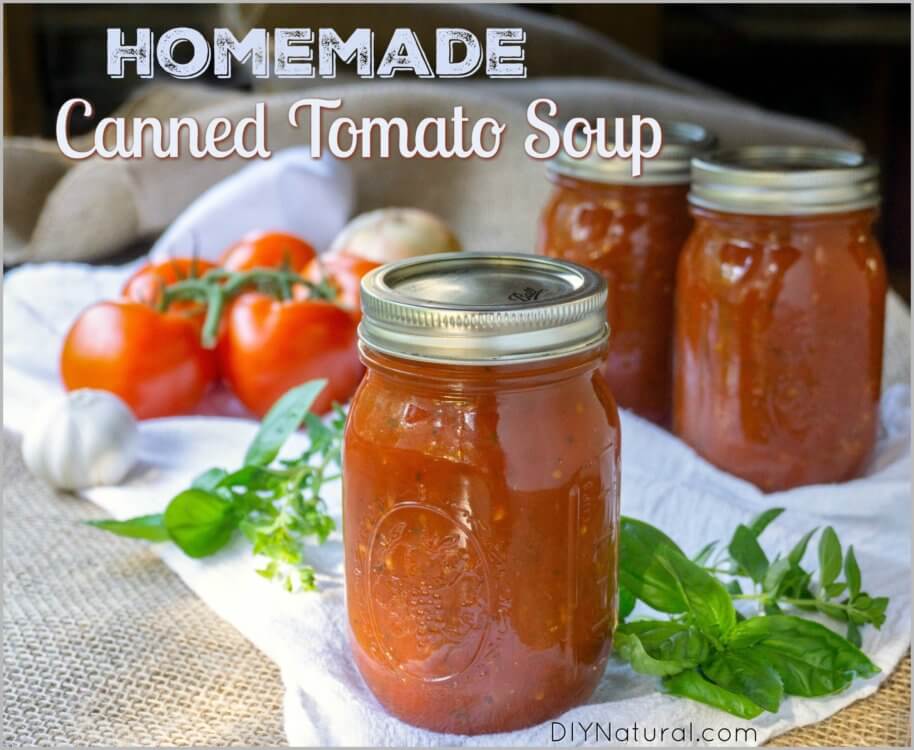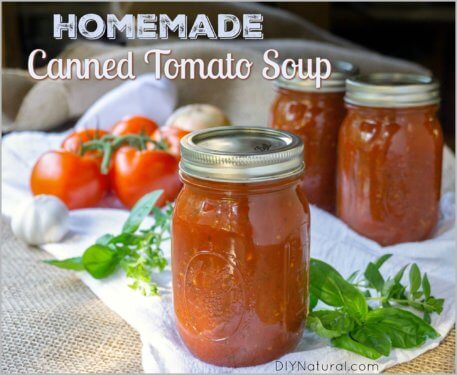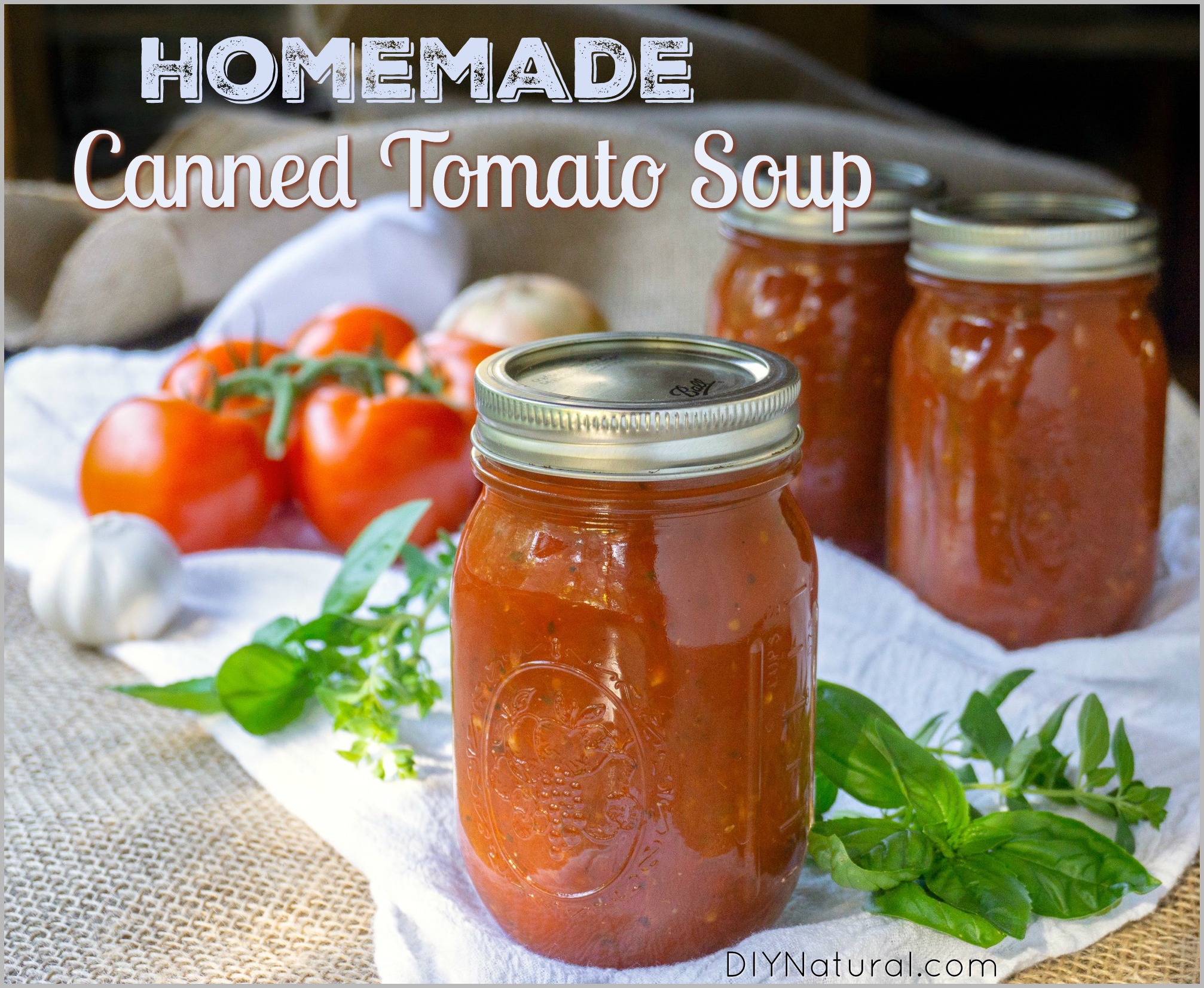
This homemade canned tomato soup recipe is for those who love my previous tomato soup recipe but also wanted a recipe they can preserve.
When I shared my husband’s favorite homemade tomato soup recipe a while back, many of you asked if it could be canned.
Unfortunately, making a homemade canned tomato soup is a bit more complicated than throwing any tasty recipe in jars and sending them through the canner. So, I set out to find another tomato soup recipe that my husband would love. This time, it needed to be canning-friendly.
Homemade Canned Tomato Soup: A Few Rules
The tricky thing about making canned tomato soup is that many recipes use ingredients like flour as a thickener or cream for added texture and flavor. Neither of these can be safely canned, even with a pressure canner.
The other thing about making it for canning is that you need to use an acid.
When you can tomato soup, you have to make sure the acid level is high enough that it will be shelf-stable. But you also don’t want that acid level to affect the soup.
When canning tomatoes, The National Center for Home Food Preservation advises that you use no more than 3 cups of vegetables for every 22 lbs of tomatoes. If you add too many vegetables, you dilute the natural acid from the tomatoes, and your soup is no longer able to be canned.
Sticking to this advised ratio, I added most of my flavorings for this soup in the way of dried herbs and spices.
How To Make Tomato Soup For Canning
Once you have a good recipe, made for putting in jars, the process is pretty straightforward:
- cook vegetables until very soft
- puree the vegetables
- season the soup
- reduce the soup
- can it!
I used a high-powered blender to puree our cooked tomatoes and onion. There were only a few small tomato bits left after blending so I didn’t bother straining my soup.
If you have a blender that doesn’t sufficiently chop up tomato skins, you might want to strain the soup before seasoning and reducing it. Alternatively, use a food mill to puree the tomatoes and get rid of the skins.
What Tomatoes Should I Use?
The best tomatoes to use are “paste” tomatoes. These are tomatoes that have thicker, meatier walls and contain less water.
This means there will be more tomato and less juice, and the soup will thicken up faster. This is important because you cannot use thickeners in homemade canned tomato soup.
Probably the most commonly known “paste” tomato is the Roma tomato. These little tomatoes have great flavor and work wonderfully for making homemade tomato soup.
Adding Acid For Canning
As I mentioned, acid is important in ensuring your homemade canned tomato soup will stay shelf-stable.
To really make sure the acid level is correct, it is common to add lemon juice or citric acid to the jars when you are canning anything tomato related.
You might be worried that lemon juice would affect the flavor of the soup. It does, but only slightly. And your soup won’t taste lemony at all. Rather, it just tastes slightly brighter.
Citric acid doesn’t alter the flavor of the soup at all. So if you’re concerned about the lemon flavor, use citric acid.
However, there is another factor. When you add milk to the tomato soup that had citric acid in it, the milk separated a little. When added to the soup that had lemon juice, the milk separation was barely noticeable.
I’d rather have a slightly brighter soup with less milk separation. Choose which route is best for your tastes!
Serving Homemade Canned Tomato Soup
Keep in mind that you are making a slightly condensed tomato soup. The finished soup should be slightly thicker than you like to serve it, particularly if you like to add cream or milk to it.
Finally, to serve the canned tomato soup, simply pop open the jar, pour it into a bowl or saucepan, add as much milk or cream as you desire, and reheat.
It’s so easy, and it’s a great way to have a quick lunch or dinner ready in no time. This is the perfect way to preserve your summer tomatoes so you can enjoy them all winter long! (And you skip all the extra salt and additives in the store-bought cans of tomato soup!)

Homemade Canned Tomato Soup Recipe
This homemade canned tomato soup recipe is for those who love my previous tomato soup recipe but also wanted a recipe they can preserve.
- Prep Time
- 20 minutes
- Active Time
- 2 hours
- Total Time
- 2 hours 20 minutes
- Servings
- 4 pints
- Courses
- Dinner, Lunch
- Cuisine
- American
- Estimated Cost
- $2
Equipment
Ingredients
- 7 lbs tomatoes (Romas work well)
- 1 cup yellow onion (diced)
- ½ cup filtered water
- 3 Tbsp tomato paste
- 3 Tbsp brown sugar
- 1 Tbsp dried oregano
- 2 tsp dried basil
- 2 bay leaves
- 2 tsp granulated garlic
- 1½ tsp salt
- 1 tsp celery seed
- ½ tsp black pepper
- lemon juice or citric acid (for canning – find organic citric acid here)
Instructions
-
Quarter tomatoes and dice the onion. Place them in a large soup pot along with ½ cup of water. Cook, uncovered, for 30 min – 1 hour, stirring occasionally, until tomatoes are very soft.
-
Remove tomatoes from the heat and let them cool slightly. Working in batches, transfer the warm tomatoes to a food processor, blender, or food mill to puree. If desired, press the tomato puree through a fine-mesh sieve to remove any seeds and skins.
-
Pour the smooth tomato puree back into the large soup pot. (Using a very wide-bottomed pot will give you more surface area as you reduce tomatoes, making the process take less time.)
-
Add the tomato paste, sugar, herbs, and spices. (Everything EXCEPT the lemon juice or citric acid.)
-
Bring seasoned tomato puree to a simmer. Cook tomato soup until it has reduced to the thickness you desire. (Mine took 1 hour of simmering.)
-
While the soup is simmering, wash canning jars and keep them warm. Prepare the water bath canner.
-
When the soup has reached the desired thickness, taste it and adjust salt as desired.
-
Add 1 Tbsp of lemon juice to each pint jar or 2 Tbsp lemon juice to each quart jar. (Or ¼ tsp citric acid to each pint and ½ tsp citric acid to each quart.)
-
Fill jars with the soup, leaving ½ inch of headspace. (I like to use a canning funnel to reduce spills and messes.)
-
Wipe the rims clean of any spilled soup. Then cover the jars with fresh lids and rings.
-
Process your canned tomato soup in a boiling water bath canner for 40 minutes for pints or quarts. (Adjust the processing time as needed for your altitude.)
-
After processing, carefully remove the jars from the water and set them on a cooling rack.
-
Once the jars and soup have cooled, remove the rings and check that your lids have sealed.
-
Finally, store the sealed jars in a cool place for up to a year. If any jars didn’t seal properly, refrigerate them immediately and eat within a week.
Recipe Video
Notes
The amount of soup you end up with will depend on the type of tomatoes used and how much you reduce the soup. The type of tomatoes used (how much water they contain) will also determine how long the soup needs to cook to reduce down to your preferred consistency.
To Serve
Reheat your canned tomato soup with some milk or cream, as desired.
Nutrition:
Made this recipe?
Mention @diynatural or tag it #diynatural!
Tell us what you think in the comments below!
*******




I do not take a chance canning the f8nnished soup. I par boil the tomatoes then put it through my antique cone sieve. Keep all the tomato pulp, throw away the skins.
Then I cook my soup base at a simmer to reduce slightly. I add oregano, basil, salt and pepper plus two tablespoons of sugar.
When it is reduced enough, it all depends on what you want, I add one tablespoon of lime juice to each jar, add soup and put on tops and rings. Make sure to clean the jars first of any spilt soup base(best done with clean paper towel) then 35 minutes into my canning pot. Let them cool and shelve them. When you want soup you have a good base already.
Love this recipe! I add a touch of cayenne for a little zing. My daughter went off to college this summer and took all of my stash with her. Time to make more!
Whoops! I forgot to put the lemon juice in the jars. They are already in the boiling water bath. Is all lost? Or will they be fine? Thanks! I made this last year and it is hands-down my husband’s favorite tomato soup!
You HAVE to have the lemon juice or citric acid in the jars! Just dump them all back into a pot, re-heat, then complete the process (using new seals).
Or else what? I would think the tomatoes are acidic enough? And they’ve already been sitting almost 24 hours. Maybe Sarah or Matt could chime in.
Hi Suzy. Different tomatoes have different levels of acidity. Some would be fine, other may not be. Without pH testing your soup, it’s impossible to know if it falls within the ‘safe’ levels for home canning. That being said, if I were in your shoes, I would likely leave it and just make a note to use the soup sooner rather than later. (Definitely no loner than 6 months on the shelf.) I would really pay attention to look and smell when I open the jars, and heat to a good boil before eating. But, that’s just what I would do for myself, and not a recommendation I can give, since this is definitely a ‘use at your own risk’ situation, since it does vary from safe canning guidelines.
THANK YOU Sarah! I’ve been canning tomatoes for over 40 years and never added lemon juice to the jars. One year I processed and canned just over 100 quarts of tomato sauce (it was a personal best!) 😉 I had never made tomato soup, and this recipe is the best, so really enjoy making it. I’m pretty sure I forgot the lemon juice last year when I made it. No issues. I always smell anything I open after canning, and give it a good looking over. I’ll use these jars first; I’m sure it’s safe. As a side note: I still have my mother’s old Kerr canning recipe book. It tells you how many HUNDREDS OF MINUTES to process meat in a water canner! She did green beans and everything. Never used a pressure canner. No one ever got ill. But she also showed me the fine art of making sure everything was clean. You could have done surgery in her kitchen when she was canning! haha!! Thanks for the response!! Happy Canning!!
Thank you for the recipe. Is it possible to still be shelf stable without the brown sugar?
This soup is amazing! I used my Black Krim tomatoes – what a tasty soup for a cold winter day. Planning on canning more of this recipe. I didn’t put the bay leaves in the first batch but will try it on the next batch. Thank you so much for this really great tomato soup recipe!
can this be canned in a canner instead of a water bath?
Instead of using milk, could I use almond milk or cream? Or could I even leave that out and just add it when I reheat it?
Not the person who posted, but the milk shouldn’t be added until after reheating, milk products are not safe to home can so you can add it when you open the jar to heat it up and eat it, if you prefer it and honestly that’s completely up to your taste.
Going to be trying out this recipe as have an abundance of a mixed variety of tomatoes that voluntarily grew in my garden this year. Instead of using milk, could I use coconut milk or cream? Or could I even leave that out and just add it when I reheat it?
This is not a safe recipe unless you peel the tomatoes. Washing them does not reduce the bacterial load enough to be safe from botulism. Please go to the National Center for Home Food Preservation and look up “canning tomatoes.”
Hi Catherine. I visited the site you reference but found no such information. Can you share the link you’re citing? Thanks.
Just an f.y.i….. Ball and other sources say to not store canned foods with rings on. Compromised/failed lids have the potential of reseating themselves if the ring is left on. It would then be dangerous to consume the contents. If stacking jars ( no more then 1 high is recommended) , be sure to put something like a piece of cardboard on top of the lower level to distribute the weight to avoid not being able to not discover any seals that popped.
That is correct Carolyn, we have updated the recipe accordingly. Thanks.
Is this considered a safe tested recipe?
Question…why does the boiling water bath take forty minutes?
Thanks for posting! Two questions: I’m not a fan of adding cream/milk to tomato soup so would I cook it down to the consistency I want the final product to be or would I thicken it more and plan to add water or stock to thin when I reheat (or does it matter?). Second – there’s a fantastic red pepper/tomato soup in a carton on the market. Do you have a recipe for something like that? Preferably without added sugar? I tend to use ground carrots in my tomato sauces to avoid adding sugar to balance. Thanks!
How much lemon juice should be added?
Hi Laura! Step 8 says, “Add 1 Tbsp of lemon juice to each pint jar or 2 Tbsp lemon juice to each quart jar. (Or ¼ tsp citric acid to each pint and ½ tsp citric acid to each quart.)”
Hi Laura. You add the lemon juice in step #8 to the individual jars. Add 1 Tbsp of lemon juice to each pint jar or 2 Tbsp lemon juice to each quart jar. Enjoy!
Got one batch finished while baking and other stuff. Visiting my grandson tomorrow. Meemee has treats will travel lol. Anyway, this recipe made my kitchen smell amazing! It tastes like dining in an expensive Italian restaurant! Will make another batch later…my feet are swollen lol. I highly recommend this recipe?
I couldn’t find “granulated” garlic. Will minced garlic be ok, and if so, how much?
Thanks.
Same here. I’ve got tons of regular garlic
Hi Lynne and Sue. I choose granulated garlic for this recipe because it can be tricky to safely can fresh garlic unless you are pickling it using a high amount of vinegar. Since I can’t guarantee that the acid levels of this soup will be high enough to safely can the garlic, I can’t recommend the use of fresh garlic in this recipe. If you can’t find minced garlic, garlic powder would be my next recommendation (at the same amount as the granulated). Using an already dehydrated form of garlic is the only way to ensure you have a safe canning environment with regards to the garlic in this recipe. Enjoy!
I made a variation of this recipe, I only used tomato’s roasted fresh with onion and garlic roasted with them. I puréed it, strained and heated but didn’t add the lemon juice or citric acid. I did mix some ricotta cheese in when heating to a boil on the stove. Canned 25 mins. Will the cheese effect the acidity to where it’s not shelf stable without the added acid. Great recipe!! This is my first time canning in years so I’m a bit rusty
Hi Beth. I would NOT trust your variation of the soup to be shelf stable. First, the added acid is an important element in being sure the acidity is high enough to keep this soup safe on the shelf. Secondly. it is not recommended to can anything with dairy in it because of the fat. If you like ricotta in your tomato soup (and that sounds quite tasty), I would recommend adding it before serving the soup, rather than for canning.
The soup that you just made, I would recommend freezing, if you made enough that you would like to save it for later.
Fine recipe!
How long would we process the jars in a pressure canner?
Hi Marlene,
I’m not familiar with using a pressure canner. But, I would follow the same process that you would for canning tomatoes.